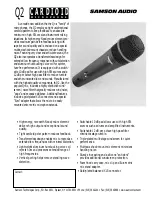
6
Paging System Operation
Your
WaveWare Paging System
includes a UHF transceiver, and onboard RS-232 communications, that transmits
paging messages using the industry standard POCSAG paging protocol. The RS-232 communications allow you to
interface the paging system to a PC or to other devices and systems that use RS-232 serial communications (Host
Devices). Other models of
WaveWare Paging System
products include encoder only models, and the combination
of the paging encoder with VHF and UHF radio transceivers.
The types of paging receivers that are compatible with your
WaveWare Paging System
include:
!
Any POCSAG compatible paging receiver operating on the same frequency as the paging transmitter (in
the UHF band) and operating at 512, 1200, or 2400 bps data rate. Pagers of this type include tone/vibe,
numeric, and alphanumeric models.
!
WaveWare Wireless Message Centers, operating at the same frequency as your paging system. WaveWare
Wireless Message Centers are normally configured to receive at a 512 bps data rate.
The paging system may be controlled by a PC, or other control system, that is running software designed to
interface to the paging system. WaveWare wireless communication systems software is designed to take full
advantage of the features of your
WaveWare Paging System
. The TAP, WaveWare, COMP1, and COMP2
interface protocols are defined in this handbook to allow you or others to develop software or devices to directly
control the transmitter.
The paging system maintains an input buffer, which can continuously receive commands from the Host Device
while paging messages are being transmitted. When a command is received from the Host Device, the paging
system responds with a message back to the Host Device. The paging system encodes the paging messages into
POCSAG paging format and transmits the encoded paging message to the paging receivers of your choice.
PC software developed to utilize the
WaveWare Paging System
can be designed to maintain a simple database of
pager ID numbers, or the software can be designed to allow definition of paging receiver attributes, including:
Pager Type
Φ
Tone/Vibe Only, with or without multiple tone/vibrate cadences
Φ
Numeric
Φ
Alphanumeric
Capcode - The unique address assigned to each paging receiver
RF Data Rate
Φ
512 bps
Φ
1200 bps
Φ
2400 bps
Function Code – One of four values that pagers can use to change how the behave when receiving a new
message
The Transmitter Unit may require the setting of an onboard DIP switch to change communication interface
parameters. Refer to Appendix B – DIP Switch Settings for details on how to configure the DIP switches, as
required.
If you want to use the TAP interface protocol with 1 to 4 digit pager IDs, you will need to configure a pager
database, using the WaveWare Paging Encoder Setup software. You can obtain the WaveWare Paging Encoder
Setup software either from the WaveWare Product Support CD or from the WaveWare web site, at:
http://www.wirelessmessaging.com/media/encodersetupv7/WWEncoderSetupV7.exe






































